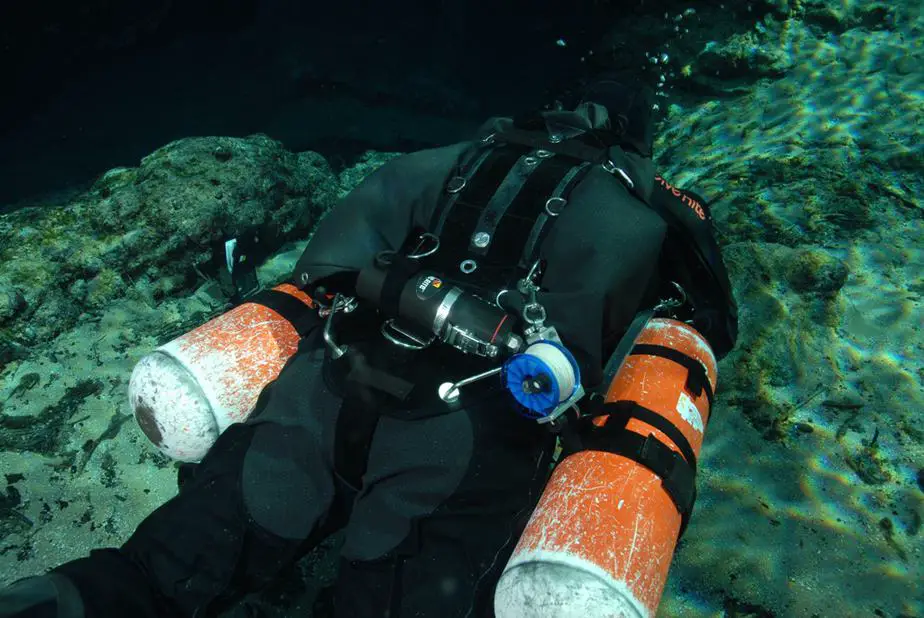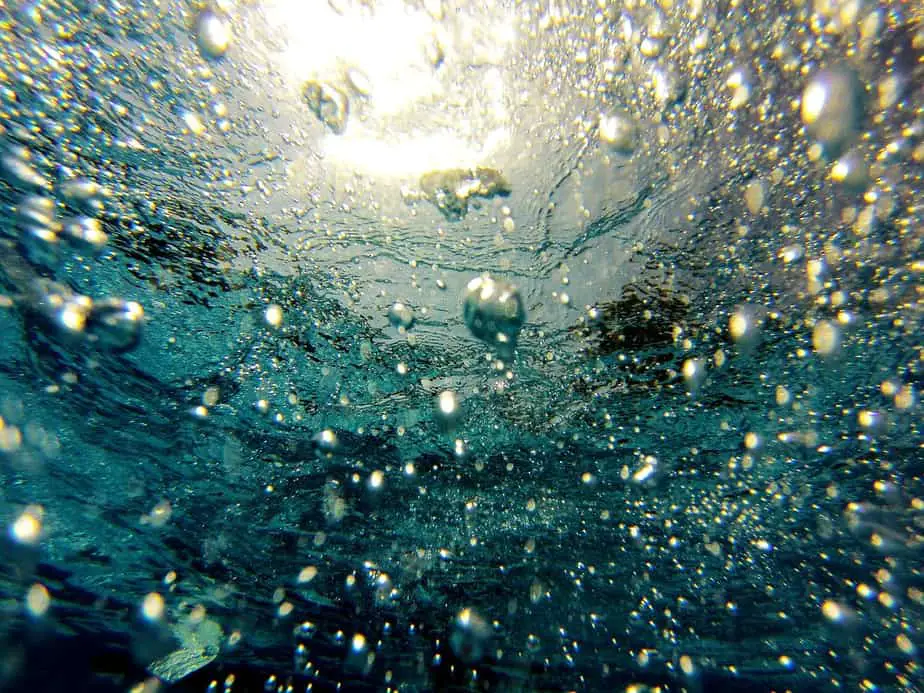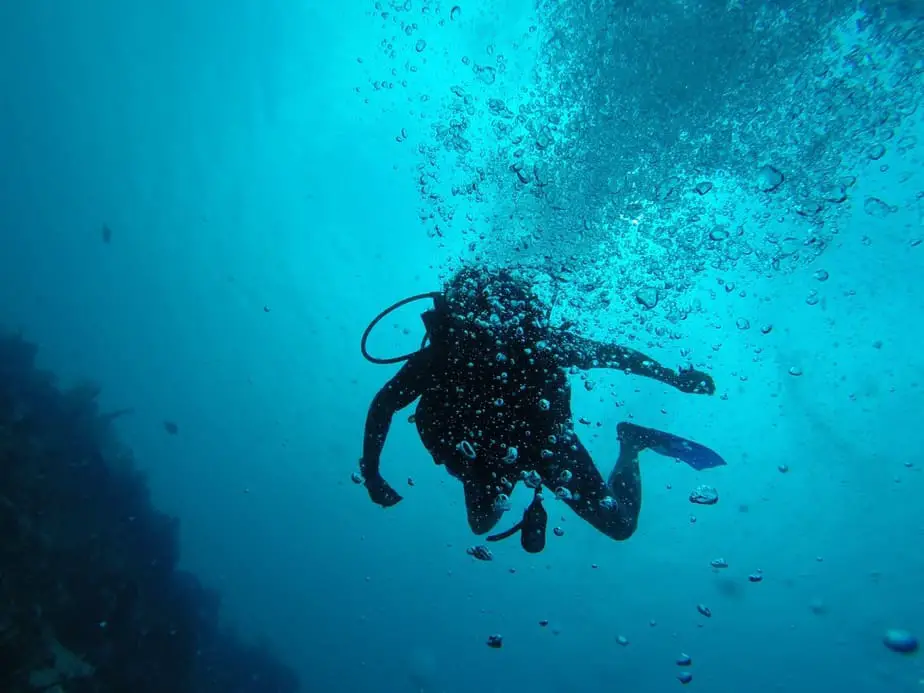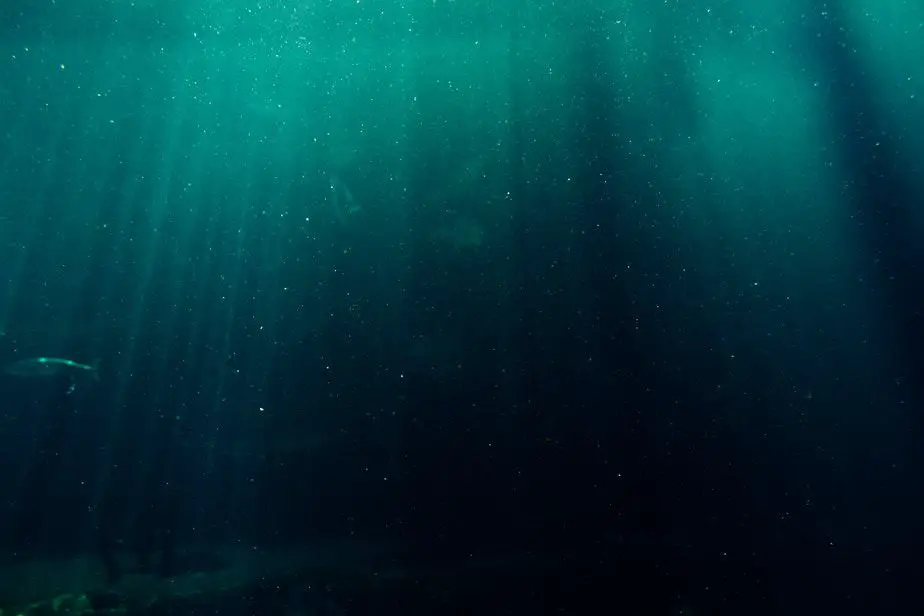One of the first things a new scuba diver asks is how deep they are allowed to dive. There is a misconception, particularly from younger, wide-eyed, wishful divers, that with their trusty scuba tank and regulator they can dive to any depth. They don’t yet know about the dangers of nitrogen narcosis, oxygen toxicity, running out of breathing gas, and the extreme pressures experienced at deep depths.
Now, the answer to the question “how deep can a scuba diver dive” is not that straightforward; you’re going to have to be more specific. For starters, there are official limits you should adhere to depending on what scuba certifications you have, and these limits have been set by the various scuba diving certification organizations.
But, you’re not here to learn about any “official” diving limits, are you? Staying within the rules doesn’t sound exciting enough. You’re here to learn about the trailblazing, adrenaline-fueled, death-defying dives that only the most exceptional scuba divers have done – and how deep those guys have gone, right?
In that case, the world record since 2014 for deepest dive by a human with scuba gear was 332.25 m (1,090 ft 4.5 in). For reference, that is over three times deeper than what the maximum technical diving limit is (100 m). At those depths, you are seriously risking your life, and even if you’re crazy enough to do it, it doesn’t mean that your body can handle it.
So, is 1,090 ft. really the deepest a scuba diver can go? Currently, since only one person has accomplished that, we can assume that everybody else will have a (much) lower depth limit.
Why couldn’t that diver (or others) go even further; why stop at 1,090 ft? The reason that the world record holder could not proceed further is a combination of extreme water pressure, nitrogen narcosis, oxygen toxicity, and high pressure nervous syndrome putting his body through hell. The fact that this record has stood for years (despite some controversy) is a testament to how dangerous and difficult it was to accomplish.
We’re going to discuss these various scuba diving depth limits in more detail, including the world record setting one. The rest of this article will focus on the factors that limit us from diving even further and the biggest risks associated with diving too deep.
Depth limits set by scuba diving certification organizations
For someone who only has the most basic Open Water Diver certification (the vast majority of scuba divers) the maximum limit is only 18 m (60 ft). The upper limit for what’s considered recreational diving is 40 m (130 ft), which you’ll learn to safely reach in the Deep Diver course.
As you take more courses and rack up the certifications, your maximum dive depth will continue to increase. You’ll be taking the various technical diving courses offered by your preferred scuba educator, and at least for PADI, if you complete the Tec 100 CCR course then you can then dive to a maximum depth of 100 m (330 ft).
Keep in mind, these limits are not set by the government. If you go past these limits, you aren’t necessarily breaking any laws (rules or best practices, maybe). There won’t suddenly be police sirens screeching underwater and scuba diving police officers coming to arrest you. If you’re wondering what happens when people go beyond these limits, that’s when things get interesting and that will be the focus of the rest of this article.
What happens when you go past these depth limits?

As it currently stands, the world record for deepest dive wearing scuba gear is 332.25 m (1,090 ft 4.5 in), which was achieved by Ahmed Gabr in Dahab, Egypt in 2014. It took 12 minutes to descend to that depth but over 15 hours to surface because he needed time to safely decompress.
Over the course of the dive, Gabr used 92 tanks of breathing gas, which is about 89-90 tanks more than what I usually use. Also, this world record has stood for years and remains to be beaten. Use this as a point of reference for those who think you can dive very far with just scuba gear.
Finally, we get into commercial deep sea diving. At this point, we are going beyond the scope of this article somewhat. Deep sea divers can dive as deep as 610 m (2,000 ft) underwater using specialized equipment such as atmospheric diving suits (ADS) and diving bells. They might also use remote operated vehicles or autonomous underwater vehicles. Again, this is not possible using traditional scuba gear, but it’s interesting to see the difference in depth that is achievable.
Risks of diving too deep
When we think of the risks of diving too deep, the layperson would most likely think of running out of air or getting crushed by the water pressure. However, experienced divers know that there are more urgent concerns that need to be addressed before one is at risk of getting crushed like the aforementioned running out of air. That said, the water pressure is a concern, just not the biggest one.
More specifically, the pressing concerns I am referring to are things like decompression sickness, nitrogen narcosis, oxygen toxicity, high-pressure nervous syndrome, and yes, running out of breathing gas is risky at any depth. Additionally, all of this is amplified by the fact that if you’re doing some kind of daredevil stunt like setting a world record deep dive, you likely won’t have a dive buddy with you who can rescue you if things go south.
Let’s go over each of these risks in more detail below.
Decompression sickness (the bends)
Decompression sickness, also known as the bends, is one of the biggest dangers a scuba diver must worry about, and the risk is even greater the deeper you dive. Essentially, when breathing compressed air, some of the nitrogen gas in it can get absorbed into the body’s tissues. When you ascend to a shallower depth with lower pressure, the nitrogen gas will get released, and this is known as off-gassing.
One of the most important things you’ll learn about in the Open Water Diver course is the no-decompression limit (NDL). That refers to how long you can stay underwater and surface without needing to do any decompression stops.
The deeper you dive, the shorter your NDL will be due to the pressure causing more nitrogen to get absorbed into your tissues. You can exceed the NDL on purpose if you are doing a decompression dive with planned deco stops to give yourself more time to safely off-gas.
Even when a recreational diver stays within their NDL, that doesn’t mean they can just beeline it straight to the surface with no consequences. The general consensus is that you should maintain a slow ascent rate as indicated by your dive computer, and that you should also perform a 1-3 minute safety stop a few meters below the surface before surfacing.
The risk of DCS is so great because, in an emergency event, you still cannot rapidly go to the surface without suffering extreme consequences. That’s why scuba diving, especially deep diving, requires so much redundancy; backup dive computers, backup scuba cylinders, basically anything critical should have a backup.
And what are these “consequences” of surfacing too quickly I speak of? When the nitrogen gas is rapidly released, it can form tiny bubbles in the blood or tissues. The bubbles, depending on where they form and where they travel to, can cause a variety of symptoms: fatigue, joint or muscle pain, numbness, stiff joints, weakness, paralysis, and even death.
Due to how serious the risk of DCS is, a good rule to follow is to treat all dives as decompression dives, meaning you must always do at least one stop (the safety stop) before surfacing to reduce the chances of getting bent.
Furthermore, due to how quickly the NDL is reached during a deep dive, decompression stops are absolutely needed. In Ahemd Gabr’s world record deep dive, it was reported that it only took him 12 minutes to reach depth, but over 15 hours to reach the surface. Maybe he was being overly cautious, but the extreme caution Gabr took should give you an idea of how risky DCS is.
Nitrogen narcosis
When too much nitrogen has been absorbed into your tissues, you can enter a state of altered consciousness known as nitrogen narcosis. The effects are eerily similar to alcohol intoxication.
In fact, that is also a reason why you shouldn’t drink so close to a dive; the effects of alcohol can linger even after a night of sleep and be compounded by narcosis. Typically, nitrogen narcosis is not a concern until you reach depths of 30 m (100 ft) and below.
Due to the mind altering effects of narcosis being so similar to being inebriated, which is often seen as an enjoyable pastime on the surface, it has been given nicknames like the martini effect, rapture of the deep, and narks. Don’t let these cute nicknames fool you.
While narcosis is not physically dangerous by itself unlike something like decompression sickness, the problem is that it will impair your decision making abilities. It can also make your movements sluggish. In extreme cases, some divers have removed their regulators because they thought they could breathe underwater.
Thankfully, the effects of narcosis wear off almost immediately once you’ve ascended to shallower depths and there are no long term effects. That said, there is a risk that you might ascend too quickly while still impaired which puts you at risk of the bends.
To minimize the risk of narcosis, deep divers no longer dive with just regular air. Instead, they will use mixtures known as Trimix and Heliox. These mixtures contain a lower concentration of oxygen or nitrogen, and introduces a third gas: helium. Helium can help offset some of the narcotic effects of nitrogen and even helps prevent oxygen toxicity.
Oxygen toxicity
Like nitrogen narcosis, oxygen toxicity can occur when high concentrations of a gas have been absorbed into our system, namely oxygen in this case. However, unlike narcosis, oxygen toxicity has some nasty symptoms: chest pain, difficulty breathing, seizures, and all of these can lead to an increased risk of drowning.
You might be wondering, “Wait a minute, doesn’t everybody breathe oxygen, even recreational divers? Am I in danger of oxygen toxicity?” Since recreational diving occurs at depths of 40 m (130 ft) and above, that’s not deep enough for oxygen toxicity to be an issue.
At depths of 60 m (200 ft) and below is when oxygen toxicity becomes a real risk. In order to prevent this, deep divers use Trimix and Heliox.
Gee, those two gas mixtures containing helium again; it seems like Trimix and Heliox are pretty amazing. Does that mean that breathing helium is perfectly safe? Unfortunately, no, breathing too much helium can result in high pressure nervous syndrome.
High Pressure Nervous Syndrome (HPNS)
High pressure nervous syndrome, or HPNS for short, is a neurological condition that can affect you during extremely deep dives while breathing helium gas. Symptoms include muscle twitching, tremors, fatigue, and dizziness. It can be caused by a fast rate of descent as well as the absolute pressures experienced at depths of 150 m (500 ft) and below.
To reduce the likelihood of HPNS, deep divers need to descend slower. They can also use gas mixtures that contain hydrogen. Currently, it seems that HPNS is the biggest limiting factor preventing divers from reaching deeper depths since it cannot be prevented.
In the world record deep dive that Ahmed Gabr set, he reported experiencing HPNS at a depth of 290 m (951 ft). Being ex-Special Forces and an experienced diver, he used his training and discipline to focus on the dive. He would push through the discomfort until he reached 332.25 m (1,090 ft 4.5 in).
Keep in mind, what Gabr did was extremely risky. He also clearly had the mental and physical fortitude to understand what was going on and endure even more punishment. This is not typical of the average diver, or even an experienced diver. There’s a reason why that record has not been beaten in years.
Running out of breathing gas

At shallow depths (say, 10 m or shallower), you don’t have to worry so much about how long your breathing gas will last. You could easily dive for 45 minutes or even an hour with only a single AL80 tank. That’s not the case when it comes to deep diving because the deeper you dive, the higher your breathing gas consumption will be.
The reason for this is that as you get subjected to more water pressure, the volume of air in your scuba cylinder (and your lungs) shrinks. The general rule is that for every 10 m (33 ft) of depth, the pressure increases by 1 atmosphere/bar.
According to Boyle’s Law, pressure is inversely proportional to volume. So at a depth of 20 m, where there is 3 times the atmospheric pressure compared to the surface, your breathing gas will only last ⅓ as long. At 30 m, where there is 4 times the pressure, your breathing gas would only last ¼ as long, and so on.
Again, going back to Ahmed Gabr’s world record deep dive, he ended up using 92 tanks of breathing gas. It also took him over 15 hours to surface from the abyssal depths he was at because he needed an abundance of time to off-gas. How often do you go diving with 92 scuba cylinders and stay underwater for hours at a time?
You also have to factor in the cost of filling so many scuba tanks. Helium is not cheap, and you will definitely need it for deep diving. The logistics and costs required to conduct a deep dive is too prohibitive for most people.
As it stands, deep diving to depths of 1,000 ft and beyond is limited to only the most extreme individuals who also have the support of a team, not something the average diver can do on their own.
Diving physiology – understanding the limits of the human body

How deep you can dive can be explained by physics. When we are subjected to the pressure at depth, nitrogen and other gasses can be absorbed into our tissues at higher concentrations than at the surface. Specifically, the partial pressures of the gasses increase and are stored in our tissues until we ascend to a lower pressure environment. The only exception is oxygen because, though it can be absorbed, our bodies use it for metabolism.
Absorbing an excessive amount of nitrogen can be an issue for two main reasons: nitrogen narcosis and decompression sickness.
The dive tables which you may or may not have seen (dive computers have largely replaced them) were developed to help divers understand and calculate how long they can stay at certain depths before their body absorbs too much nitrogen. Following these tables (or a dive computer) can drastically reduce the likelihood of decompression sickness.
If nitrogen is such an issue, is there a way to breathe less of it? In fact there is – by removing nitrogen from a mixture and therefore having a higher concentration of oxygen, we get what’s called enriched air nitrox, or just nitrox for short.
Unfortunately, nitrox isn’t a perfect solution either. Since high concentrations of oxygen is toxic, breathing too much enriched air can result in oxygen toxicity. A common symptom is convulsions which can lead to drowning.
For this reason, there are different blends of enriched air and you must specifically calculate your maximum operating depth and how long you plan on diving to stay safe. You can learn all about how to do this in the Enriched Air Nitrox Diver course.
How deep can you dive before you get crushed?

This is all hypothetical since no human has gotten crushed and survived to tell the tale. It is estimated that human bone crushes at a pressure of 11,159 kg per square inch. To achieve a similar amount of water pressure, someone would have to be 22 mi (35.5 km) deep underwater. Except, that’s literally impossible because that’s over 3 times deeper than the deepest part of the ocean.
Besides, if it takes that much pressure to crush bone, your organs would have long since been crushed by then, killing you before the rest of the body has a chance to be crushed. This is also completely ignoring the risk of oxygen toxicity, decompression sickness, high pressure nervous syndrome, or your lungs literally shrinking to a tiny fraction of their normal size.
Even in the 2014 world record deep dive set by Ahmed Gabr, who is ex-Special Forces and a diver with over 17 years of diving experience at that time, he noted that he was suffering from HPNS near the bottom of his dive and that he was forced to begin ascending due to his body shaking violently. This was felt at a depth of “only” 290 m (meters, not miles), which is far from being crushed yet his life was already in danger.
So, realistically, we know that multiple scuba divers have reached 300 m (1,000 ft) depth with only scuba gear and have safely surfaced to tell the tale. The current world record is 1,090 ft which has not been bested for years.
Rather than asking how deep one can dive without being crushed, it’s better to ask how deep one can dive in scuba gear while still surfacing alive and well. That number seems to be around 1,000 ft, and we’re still waiting on the next brave soul/pioneer to break that record without losing their life or being permanently injured.

